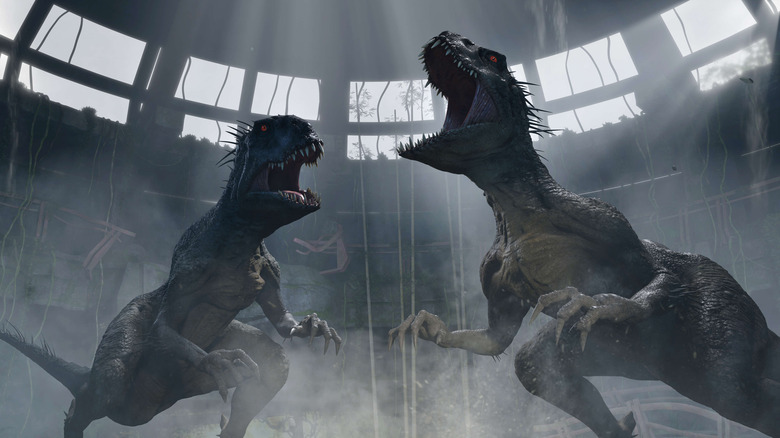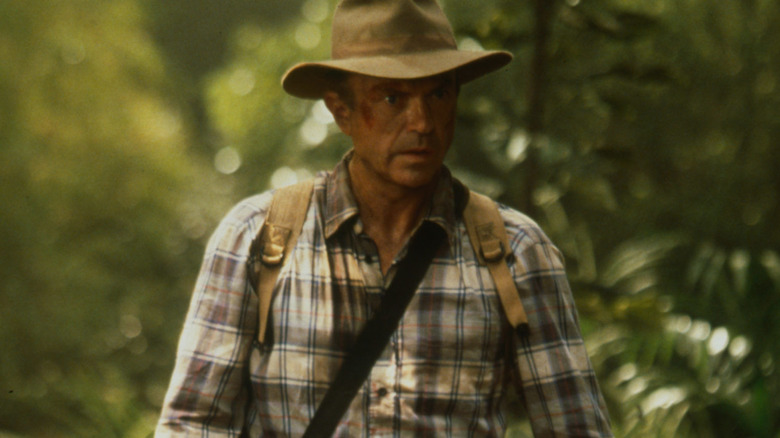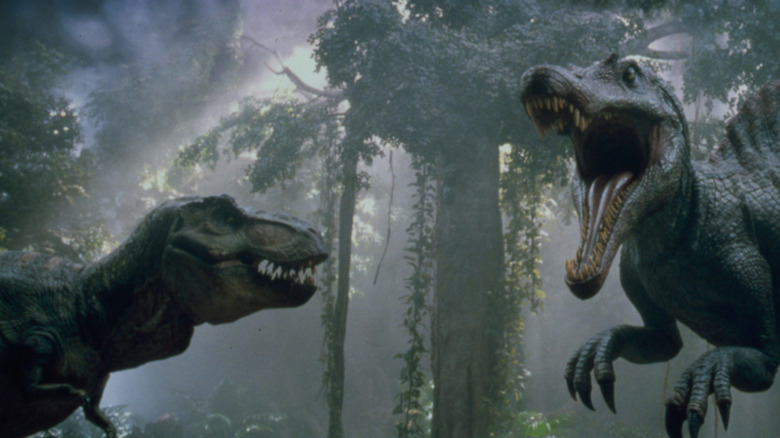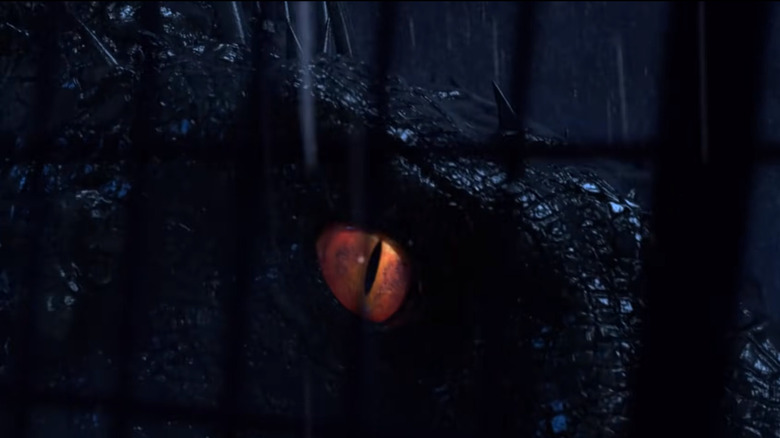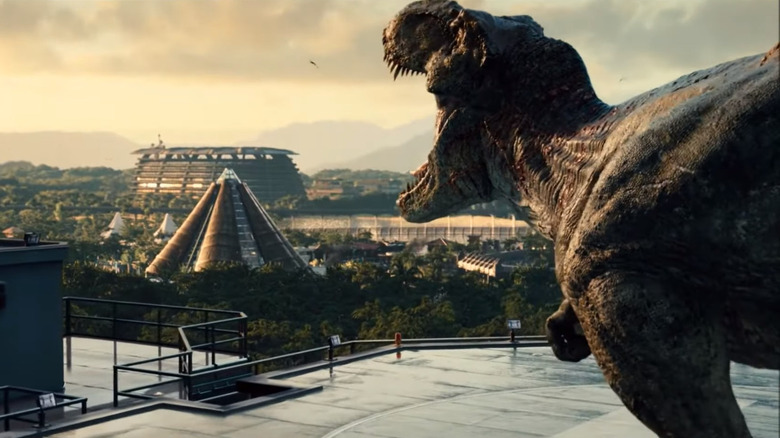The Very Weird Version Of Jurassic Park 4 We Never Saw
The "Jurassic Park" franchise moved like clockwork for its first several years of existence. Steven Spielberg's original 1993 blockbuster classic based on Michael Crichton's book of the same name was such a big hit that it was impossible for Universal Pictures not to turn it into a franchise. Four years later in 1997, Spielberg returned to direct "The Lost World," and four years after that, Joe Johnston took over the director's chair for 2001's "Jurassic Park III," a movie that effectively killed the franchise for 14 years until "Jurassic World" arrived in 2015.
But it wasn't so simple as "Jurassic Park III" being a disappointment that led to Universal putting the cash cow franchise in time out for more than a decade. Spielberg actually hatched plans for a version of "Jurassic Park 4" all the way back in 2001. Various versions of the film languished in development hell for years and years, with different writers coming in to try and cook up something that would actually get made. Many ideas were considered, but none took hold and, eventually, director Colin Trevorrow decided to show us a fully functioning version of the dinosaur-filled theme park with 2015's "Jurassic World."
That proved to be a good decision as "Jurassic World" still ranks as one of the biggest movies in history, paving the way for two blockbuster sequels in "Fallen Kingdom" and "Dominion." But it almost wasn't this way. At one point, a version of "Jurassic Park 4" was in the cards that was so incredibly bizarre that, in hindsight, it's genuinely difficult to believe as an actual idea connected to this particular franchise.
The John Sayles Jurassic Park 4 script
In the early 2000s, after several writers came in and attempted to get a version of "Jurassic Park 4" off the ground, John Sayles was recruited to have a crack at it. Known for writing monster flicks such as "The Howling" and "Alligator," as well as the thriller "Lone Star," Sayles worked on the film sometime around 2003 or 2004. In a 2007 interview, the writer explained that he "worked on Jurassic Park two or three years ago. I did a couple drafts of it and I really don't know if that organization is even pursuing that movie right now." This script is somewhat famous within the fan community as it included, amongst other things, human/dog hybrids. Yes, really. In that same interview, the writer stated:
"All I know was that they didn't want to make the movie unless it was something that was going to be great and new. They weren't going to just go back to the island and have some people land on the island and get eaten."
Indeed, Sayles did not set out to make that kind of movie. Rather, he would aim to take genetic experimentation to a whole new level, infusing dinosaurs with other creatures in a movie that would take the adventure largely off of Isla Nublar and Site B.
The story of Jurassic Park 4
The story in the script as it exists centers largely on a man named Nick Harris who is described as an unemployed soldier of fortune. He is recruited by none other than John Hammond for a dangerous mission, having lost control of InGen in the aftermath of "Jurassic Park." He is sent to retrieve the infamous Barbasol shaving cream can with the dino embryos in it stolen by Dennis Nedry. Hammond would then use the embryos to create a new breed of creatures that can wipe out the remaining dinos.
A Swiss company named the Grendel Corporation has since taken over, claiming to have cleansed Isla Nublar. Nick goes to the island and retrieves the can, with dino shenanigans unfolding. He then, however, is captured by the company's CEO Baron Von Drax and taken to a castle in the Swiss Alps. There, we learn of his new species of dinosaur, the Deinonychus, which is the aforementioned dino/dog hybrid of sorts. These dinos were being trained to carry out missions in the real world and Nick ends up being the man for the job. This mirrors Chris Pratt's Owen Grady from "Jurassic World" but a key difference is we actually see some missions unfold in the script.
Eventually, the dinosaurs turn bad and the whole thing gets bloody in the end. But things got much weirder as the script that was widely circulated (which you can read here) was not by any means a completed script. What Sayles seemingly had in mind, had he soldiered on with this version, would have seen dinosaur/human hybrids that would have taken the series in a deeply weird direction.
The movie was meant to kill the franchise
Rather famously, concept artist Carlos Huante, who has worked on everything from "Men in Black" to "Blade Runner 2049," was at one point recruited to work on this particular iteration of "Jurassic Park 4." Some of his concept art leaked online several years back and, to put it mildly, it was eye-opening and caused quite the stir.
Would have love to have seen John Sayles abandoned JURASSIC PARK 4.
Concept art circa mid 2000’s shows hybrid dinosaurs spliced with human DNA. One hybrid was to feature a genetically modified human-raptor. pic.twitter.com/l6y56i1xBq
— Stephen Scarlata (@StephenScarlata) June 23, 2018
Few things make me laugh harder than the scrapped Jurassic Park 4 concept art pic.twitter.com/MT9GF2PgkT
— Adele Dazeem (@wolfofwalmrt) May 20, 2018
This artwork is very real and, as we can see, it depicts humans that have been fused with dinosaurs in all sorts of fascinating and horrifying ways. It hardly looks like something that could be part of the "Jurassic Park" franchise as we know it, but it nearly was. Or, at the very least, it was on the table. But fans will care to note that these renderings appear nowhere in Sayles' script that can be read online. So, what gives? Well, in a little-read interview, Huante explained:
"There was only a stand-in script. We were fleshing it out and making it more interesting. Those two hybrids were offered to the director so that we could have a big fight at the end of the film. The script that exists, as far as I know, was not the movie script yet."
So Sayles, it seems, was still planning to flesh out the script with even more off-the-rails ideas, well beyond dino/dog hybrids that were being used for military purposes. Huante also added that the idea was t include a fight between the T-rex man and the Triceratops man from that concept art. "It was to mimic the classic fight between both dinosaurs in their original states," he said. Huante then goes on to say that "this movie idea was meant as a franchise killer. It was to finally end this. That's why it didn't get made."
What could have been
The fascinating reveal by Huante is that this movie, should it have moved forward at Universal, would have aimed to conclude the franchise as we know it. It remains unclear why the movie was shelved but, frankly, looking over that concept art, it's not all that hard to imagine someone at the studio thinking better of it. It's also a little tough to think of Spielberg, who was producing the movie, giving the go-ahead to this off-the-rails concept. More than that, the only reason that the studio would want to keep this franchise going is that it has been incredibly reliable at the box office, even when taking the hiccup that was "Jurassic Park III" into account. Deliberately ending it would make little sense from a business perspective.
This is not a concept that was friendly to the average moviegoer. It feels more like a bizarre sci-fi blockbuster completely divorced from the works of Michael Crichton and the interpretation of that work by Spielberg. Be that as it may, it's probably for the better (at least from Universal's perspective) that they were willing to exercise patience and wait until "Jurassic World" came together as is. Still, this is a pretty fascinating bit of "what if" Hollywood history to ponder as we wonder what will come next, if anything, after "Jurassic World Dominion."
